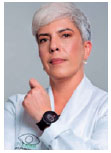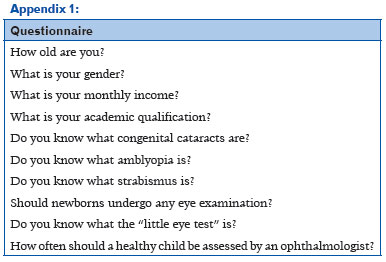Natália Fechus Monteiro1; Érika Alessandra Galembeck Silvino Rodrigues2; Isaque Souza dos Santos1; Beatriz Bandini Gonçalves1; Álvaro Alves de Campos Neto1
DOI: 10.17545/eOftalmo/2023.0052
ABSTRACT
PURPOSE: Children's ophthalmological follow-up is important for the early detection of eye conditions that compromise or may compromise the vision of children.
METHODS: The present study was developed through a questionnaire containing questions about routine pediatric ophthalmological follow-up, as well as personal information such as age and gender.
RESULTS: Participants were 120 patients. When asked if they knew what the eye test was and what its purpose was, 101 (84.2%) patients answered that they did not know what the test was and 19 (15.8%) answered that knew, having as main purpose cited the evaluation of the "baby's vision" (8).
CONCLUSION: In view of the social and epidemiological profile of the interviewees, it appears that most of the interviewees are unaware not only of the Eye Test, but also of the obligation to do so; he is also unaware of amblyopia.
Keywords: Child eye health; Red reflection; Eye Test.
RESUMO
OBJETIVOS: O acompanhamento oftalmológico infantil é importante para a detecção precoce de condições oculares que comprometem ou que podem comprometer a visão de crianças.
MÉTODOS: O presente estudo foi desenvolvido por meio de um questionário, que continha perguntas sobre o acompanhamento oftalmológico pediátrico de rotina, além de informações pessoais, como idade e sexo.
RESULTADOS: Participaram 120 pacientes. Quando perguntado se sabiam o que era o teste do olhinho e qual sua finalidade, 101 (84,2%) entrevistados responderam que não sabiam o que era o teste, e 19 (15,8%) responderam que sabiam, que a principal finalidade do teste era a avaliação da "visão do bebê" (8).
CONCLUSÃO: Tendo em vista o perfil social e epidemiológico dos entrevistados, depreende-se que grande parte deles desconhece não apenas o Teste do Olhinho, como também a obrigatoriedade em fazê-lo; desconhece também a ambliopia.
Palavras-chave: Saúde ocular infantil; Reflexo vermelho; Teste do Olhinho.
INTRODUCTION
Ophthalmologic follow-up in children is important for the early detection of ocular conditions that may compromise their vision. Conditions such as amblyopia, strabismus, refractive errors, and congenital cataracts can have a negative impact on the patients' quality of life in addition to compromising their academic performance and even resulting in the development of complete blindness1.
However, even diseases traditionally perceived as non-severe can lead to substantial visual impairment.
Thus, early diagnosis and routine follow-up of children are important right from the moment of birth because some of these conditions manifest themselves in the initial days or even within the first few hours of life and may go unnoticed by other health professionals. In this respect, the importance of specialized follow-up of pediatric ophthalmology must be emphasized.
The Brazilian Council of Ophthalmology (CBO) states that approximately half of the estimated 1.4 million cases of blindness in children under 15 years of age could have been prevented2.
When analyzing the large number of children without previous ophthalmologic follow-up, particularly the number of patients with advanced amblyopia and strabismus, it is convenient to analyze people's awareness about the importance of pediatric ophthalmologic follow-up3. Hence, this study aims to evaluate this knowledge of patients at a general ophthalmology outpatient clinic in Bertioga, State of São Paulo, Brazil.
METHODS
The present study-a sample-based survey-was conducted through a questionnaire (Appendix 1) with questions about routine pediatric ophthalmological follow-ups as well as personal information such as age and gender.
The sample comprised 120 patients from the population treated at the study's facility, with a sampling error of 5%, 90% confidence level, and homogeneous population distribution. The research was performed with a non-probabilistic sample of volunteers treated at a general ophthalmology outpatient clinic in Bertioga, a city with 64,188 inhabitants according to the latest Brazilian demographic census (2022). The study was conducted between October 2020 and February 2021, and the patients read and agreed to a free and informed consent term (Appendix 2).
RESULTS
A total of 120 patients from a general ophthalmology outpatient clinic of the Brazilian Unified Health System (SUS) in the city of Bertioga participated in the study, comprising patients aged between 16 and 85 years, with a mean age of 22.80 years. Of these, 72 (60%) were females and 48 (40%) were males. With respect to family income, the majority of responses (56.7%) fell within the "up to 1 minimum wage," category, closely followed by "from 1 to 5 minimum wages" (41.7%).
Among the interviewees, 37.5% had completed elementary education, 33.3% had completed high school education, 19.2% completed junior college, and 10% held a degree in higher education.
When questioned about the performance of an eye examination in the maternity ward after the birth of a baby, 71.7% reported that no such examination was performed and 28.3% stated that some test was performed.
When asked if they knew what the red reflex test and its purpose was, 101 (84.2%) patients answered that they did not know what the test was and 19 (15.8%) answered that they knew, with the main purpose cited being the evaluation of "the baby's vision" (8), followed by the evaluation of "eye diseases" (11).
When asked about the existence of ocular alterations that become irreversible if not diagnosed before the age of 5 years, 71.7% answered that they "did not know" and 28.3% answered that they "knew" of the existence of these conditions.
Regarding the knowledge about congenital cataracts, 2 patients (1.6%) stated that they knew about the condition and 118 (98.3%) answered that they did not know what it was. Regarding strabismus, 27 patients (22.5%) said they knew and 93 (77.5%) answered that they did not know the term.
When asked if they knew what amblyopia/"lazy eye" was, 116 patients (96.7%) said they did not know and 4 (3.3%) answered that they knew. These four answers were "decreased vision in one eye", "weaker eye", "weaker vision in one eye," and "weak eye."
When questioned about the appropriate age for a child's initial appointment with an ophthalmologist, 36.7% responded "between 6 and 12 months", 31.7% said "between 1 and 3 years", 14.2% said "between 3 and 5 years," and 17.5% said "after 5 years".
The 108 patients who answered that they had children were asked if any physician had ever requested an ophthalmologic evaluation for their children and, if so, at what age. Of these, 86 (79.5%) said that they had never been recommended an ophthalmologic evaluation for their children and 22 (20.4%) said that they had been requested to do so. Among these 22 patients, the response indicating "at 5 years" was recorded 9 times (40.9%), followed by "at 6 years" (9.1%) and "at 7 years" (9.1%) of age.
DISCUSSION
According to the Brazilian Society of Pediatrics, the red reflex test, popularly known in Brazil as the "little eye test," is a simple, quick, painless, and inexpensive test. Despite this test being mandatory in both public and private maternity hospitals since 2010, a significant part of the interviewees were unaware of the test. This was especially true for the "little eye test"1,4.
Without assigning a hierarchy to the sensory organs, it is important to recognize that vision plays a critical role in determining the quality of life for every human being. Recent data from the World Health Organization (WHO) indicate that there are approximately 2.2 billion people with some degree of visual impairment. Of these, it is estimated that 1 billion cases could have been prevented if discovered and treated in time. The WHO also reports that there are 1.4 million visually impaired children, of whom about 90% live in developing or severely impoverished countries5. To make this scenario worse, researchers from the University of São Paulo at Ribeirão Preto have predicted that the number of blind people and people with some type of moderate or severe visual impairment will double by 2050, reaching a staggering figure of 535 million people worldwide6.
It should be noted that according to specific legislation in Brazil, children are guaranteed comprehensive healthcare. While there are still remote areas in Brazil facing challenges such as limited access and inadequate medical and hospital services, it is necessary that the stakeholders in the field of healthcare and social assistance sectors collaborate and endeavor to implement initiatives aimed at enhancing eye health services for newborns and children.
Legislators and other government authorities have the potential to invest in affirmative public policies aimed at promoting the inclusion of people with disabilities of all kinds. However, it is necessary that laws and decrees be materialized in actions, and in this sense, the authors believe that in the wake of the work of health professionals, detection, which comes before prevention, should be more ostensible7,8.
Vision is a prerequisite for quality of life and its repercussions in the wake of equal opportunities for social advancement, pursuit of happiness, an inherent attribute of human dignity, and a constitutionally protected attribute. It is inhumane, even hypothetically, to accept that a child should become susceptible to any disabilities owing to the omission or negligence of health professionals, especially visual disabilities, which is the objective of the present study.
In conclusion, it can be seen that there is a need for improved public dissemination of protocols aimed at enhancing children's eye health. This can be achieved via appeals and advertising campaigns officially promoted by the Ministry of Health and can be replicated in far-reaching media, such as digital and television media, so that the culture of undergoing periodic ophthalmological examinations is established among the population. This measure should be considered as a matter of urgency as it is an efficient approach to mitigate blindness globally9.
In view of the social and epidemiological profile of the interviewees, it can be inferred that majority of them are not just unaware of the red reflex test but also of the obligation to have it performed. Additionally, they lack awareness regarding amblyopia, commonly known as "lazy eye."
REFERENCES
1. Brasil. Decreto nº 99.710. Diário Oficial [da] República Federativa do Brasil (nov 11, 1990). [citado 2015 set 17]. Disponível em: http://www.planalto.gov.br/ccivil_03/decreto/1990-1994/D99710.htm
2. Ottaiano JAA, Ávila MP, Umbelino CC, Taleb AC. As Condições de Saúde Ocular no Brasil. Editação 1-2019. ISBN: 978-8-56-210904-1
3. Brasil. Lei nº 8.069. Diáro Oficial [da] República Federativa do Brasil (jul 13, 1990) [citado 2012 out 19]. Disponível em: http://www.planalto.gov.br/ccivil_03/leis/L8069.htm.
4. Alabbasi OM, Al-Barry M, Albasri RF, Khashim HF, Aloufi MM, Abdulaal MF, et al. Patterns of ophthalmic emergencies presenting to a referral hospital in Medina City, Saudi Arabia. Saudi J Ophthalmol. 2017;31(4):243-6.
5. Relatório Mundial sobre a Visão. Organização Mundial da Saúde. ISBN: 978-92-4-151657-0. Disponível em: https://www.who.int/publications/i/item/world-report-on-vision
6. Nascimento GCC, Gagliardo HGRG. Atenção à saúde ocular de crianças com alterações no desenvolvimento em serviços de intervenção precoce: barreiras e facilitadores. Rev Bras Oftalmol. 2016;75(5):370-5.
7. Nascimento DDF, Lima Junior UM, Silva ML, Quental OB. A importância do teste do olhinho para triagem de doenças oculares no período neonatal: revisão integrativa. BJPE. 2020:6(6):69-79.
8. Finizola R, Sousa MNA, Morais NNA. Perfil do teste do olhinho: estudo em instituição de referência no Estado da Paraíba. Rev Bras Oftalmol. 2020;79(2):109-13.
9. Azad AD, Al-Moujahed A, Ludwig CA, Vail D, Callaway NF, Rosenblatt TR, et al. The Utility of Universal Newborn Eye Screening: A Review. Ophthalmic Surg Lasers Imaging Retina. 2021;52(S2):S6-S16.
| AUTHORS INFORMATION |
|
 |
» Natália Fechus Monteiro http://orcid.org/0000-0002-5039-5958 http://lattes.cnpq.br/1244207067677261 |
 |
» Érika Alessandra Galembeck http://orcid.org/0000-0002-9554-5534 http://lattes.cnpq.br/9829477515907207 |
 |
» Álvaro Alves de Campos Neto http://orcid.org/0000-0003-0309-3874 http://lattes.cnpq.br/5622330863085991 |
 |
» Isaque Souza dos Santos http://orcid.org/0000-0002-6184-5774 http://lattes.cnpq.br/1787031399223366 |
 |
» Beatriz Bandini Gonçalves http://orcid.org/0000-0003-1594-4656 http://lattes.cnpq.br/1946169559116607 |

Funding: No specific financial support was available for this study.
Approved by the following research ethics committee: Faculdade de Ciências Médicas Dr. José Antônio Garcia Coutinho — FACIMPA (CAAE: 37191320.6.0000.5102).
Conflict of interest: None of the authors have any potential conflict of interest to disclose.
Received on:
June 24, 2022.
Accepted on:
June 1, 2023.